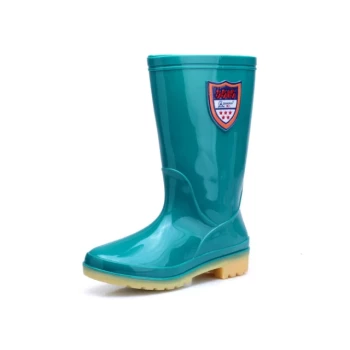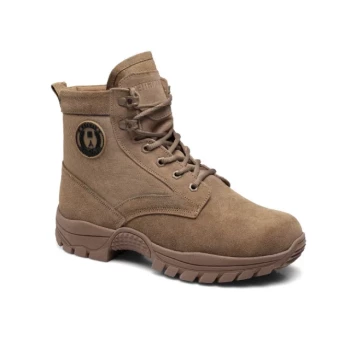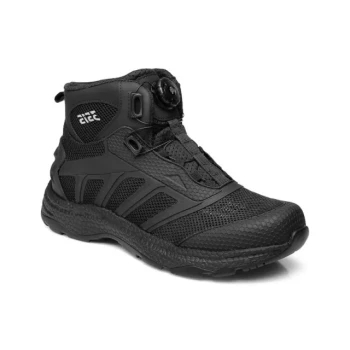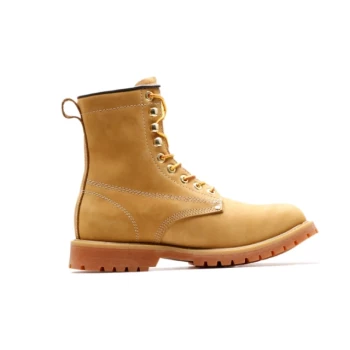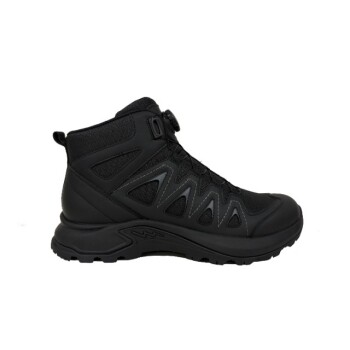At its core, a winter boot is a specialized piece of footwear engineered to keep your feet warm, dry, and stable in cold, wet, and slippery conditions. Unlike standard boots, every component—from the sole to the laces—is designed with the explicit purpose of providing insulation against the cold, resistance to moisture like snow and slush, and superior traction on compromised surfaces.
A true winter boot is not defined by a single feature, but by a complete system of components working in concert. The three pillars of this system are insulation for warmth, weatherproofing for dryness, and a specialized outsole for reliable grip.
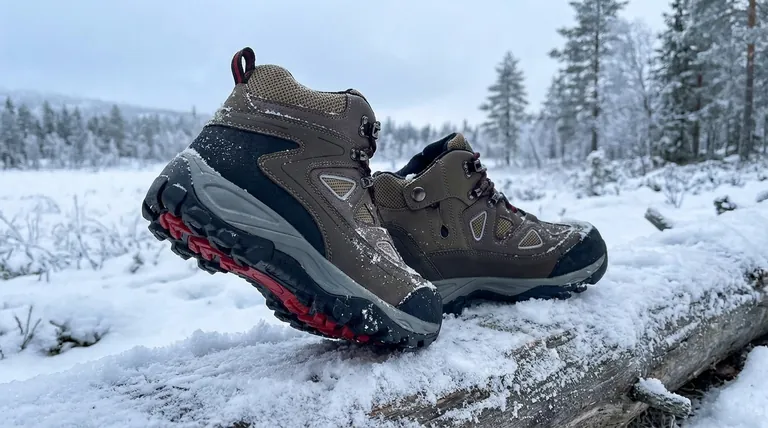
The Anatomy of a Winter Boot
To understand what makes a winter boot effective, you must first understand its construction. Each part serves a distinct and critical function in protecting your feet from the elements.
The Protective Upper
The upper is the entire part of the boot that covers your foot. In winter boots, it is your first line of defense, often made from durable, weather-resistant materials. The front half is the vamp, and the back half is the quarter.
Sealing Out the Elements
A key feature is the gusseted tongue. This means the tongue is connected to the upper along the sides, creating a barrier that prevents snow, water, and debris from entering the boot through the lace area. This is a small but crucial detail for staying dry.
A Secure and Weather-Ready Lacing System
The lacing system on a winter boot typically uses reinforced eyelets or durable D-rings. This ensures a snug, secure fit that supports the ankle and prevents heat from escaping, all while holding up to harsh conditions.
The Foundation: The Sole System
The sole is a multi-layered system responsible for support, cushioning, and most importantly, traction.
- The Outsole: This is the part that contacts the ground. It is made from a special rubber compound that remains flexible and grippy in freezing temperatures. It features deep, prominent treads and multi-directional lugs designed to bite into snow and provide stability.
- The Midsole: Located between the outsole and your foot, the midsole provides cushioning and structural support. In winter boots, it is often stiffer to distribute weight more effectively when walking on uneven, snowy ground.
- The Insole: This is the removable footbed inside the boot. It offers direct underfoot comfort and an additional, albeit minor, layer of insulation.
Core Features and Their Purpose
While the anatomy describes the parts, the features below explain how those parts deliver the performance you need in winter weather.
Feature 1: Insulation for Warmth
The defining feature of any winter boot is its insulation. This material, sandwiched within the boot's construction, works by trapping air warmed by your body heat, creating a thermal barrier against the outside cold. The amount and type of insulation determine the boot's temperature rating.
Feature 2: Weather Resistance for Dryness
Keeping feet dry is just as important as keeping them warm, as moisture rapidly pulls heat away from the body. Winter boots achieve this with waterproof materials in the upper and a sealed construction, most notably the gusseted tongue, to block moisture from entering.
Feature 3: Enhanced Traction for Stability
Standard boot soles can become hard and slick in the cold. Winter boot outsoles use specialized rubber compounds designed to stay soft and flexible. Combined with an aggressive lug pattern, this provides a much more reliable grip on both snow and ice.
Understanding the Trade-offs
Choosing a winter boot involves balancing competing needs. No single boot is perfect for every situation.
Heavy-Duty Protection vs. Lightweight Versatility
Heavy-duty snow boots offer maximum insulation and coverage, ideal for deep snow and extreme cold. However, they are often bulky and cumbersome for casual wear. Lighter, insulated boots offer more comfort and style for city use but provide less protection in severe conditions.
Full Waterproofing vs. Breathability
A completely sealed, waterproof boot is excellent at keeping external moisture out. The downside is that it can also trap sweat, leading to damp feet that get cold. Many modern boots try to balance this with materials that are both waterproof and breathable.
The Limits of Traction
While winter outsoles dramatically improve grip, they are not foolproof. Deep lugs are excellent for snow, but only specialized designs with embedded particles or metal studs can provide truly reliable traction on sheer ice.
Making the Right Choice for Your Goal
Select your winter boot based on its intended use, focusing on the features that matter most for your specific activities.
- If your primary focus is daily urban commuting: Prioritize a boot with moderate insulation, good water resistance, and a less aggressive outsole for comfort on cleared sidewalks.
- If your primary focus is deep snow and extreme cold: You need a tall, fully waterproof boot with a high level of insulation and a deep, aggressive lug pattern for maximum warmth and traction.
- If your primary focus is active winter recreation (like snowshoeing): Look for a balance of insulation and breathability, a secure lacing system for ankle support, and a stiffer midsole for stability.
Ultimately, the right winter boot is the one that correctly matches its engineered features to the demands of your environment.
Summary Table:
| Key Feature | Primary Function | Key Component(s) |
|---|---|---|
| Insulation | Traps body heat to keep feet warm | Insulating materials (e.g., Thinsulate) |
| Weatherproofing | Keeps feet dry from snow and slush | Waterproof upper, gusseted tongue |
| Enhanced Traction | Provides stability and grip on slippery surfaces | Specialized rubber outsole with deep lugs |
Ready to equip your customers with the perfect winter boots?
As a large-scale manufacturer, 3515 produces a comprehensive range of winter footwear for distributors, brand owners, and bulk clients. Our production capabilities encompass all types of insulated, waterproof, and high-traction boots designed for urban commuting, extreme cold, and active winter recreation.
We can help you source or create the ideal winter boot line that balances protection, comfort, and style for your target market. Contact our team today to discuss your manufacturing needs and get a quote.
Visual Guide
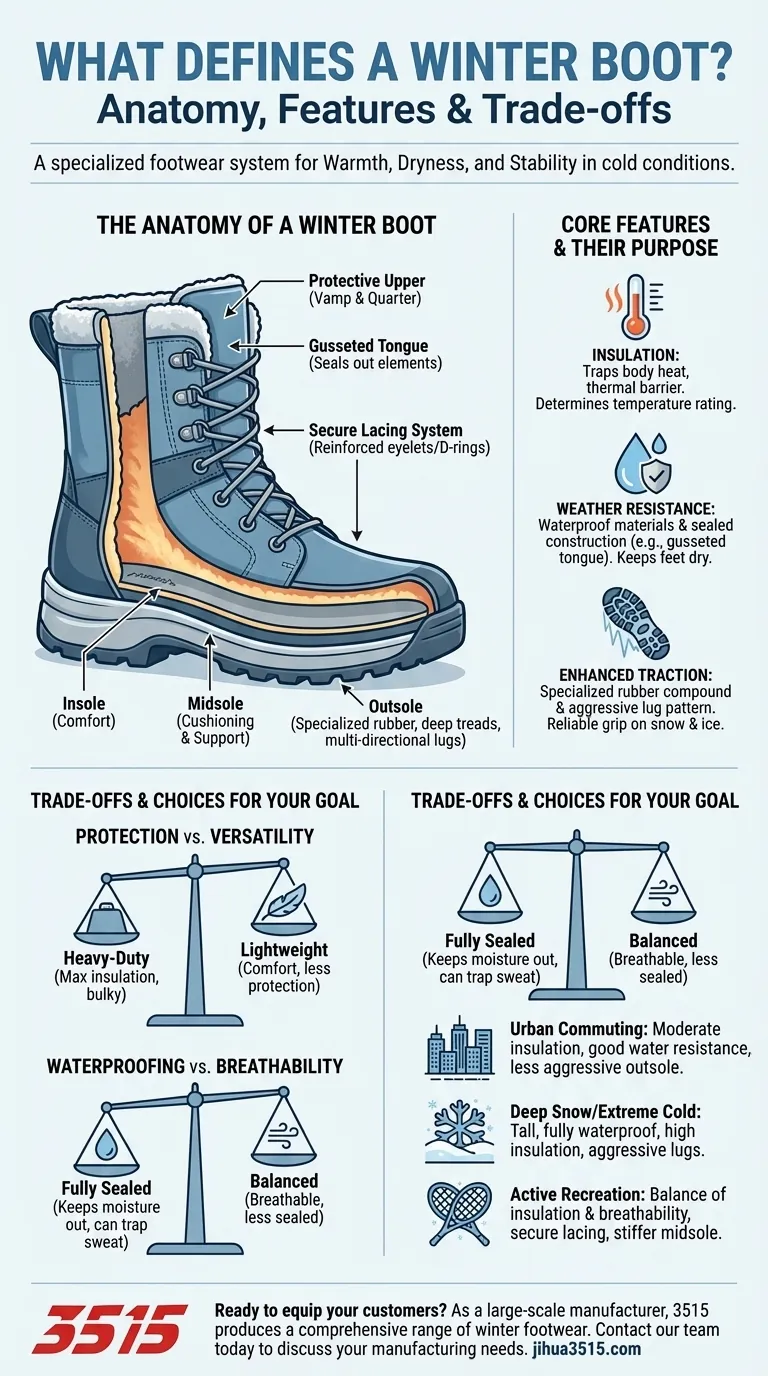
Related Products
- Safety Footwear Wholesale Manufacturer for Custom OEM/ODM Production
- Premium Wholesale Waterproof Safety Boots High Performance Protection for Industrial Markets
- Wholesale Safety Footwear Manufacturer for Bulk & Custom OEM Orders
- High Performance Fire-Retardant Waterproof Safety Boots
- Customizable Anti-Smash Safety Boots for Wholesale & Private Label Manufacturing
People Also Ask
- Do snake bite boots work? Your Ultimate Guide to Effective Snake Bite Protection
- What are OSHA approved shoes? Understanding the Correct Standards for Workplace Safety
- What cultural and environmental considerations are tied to wearing shoes indoors? Balance Hygiene, Tradition, and Foot Health
- Is it normal to wear shoes in the house? A Guide to Hygiene, Comfort & Culture
- How do safety shoes contribute to cost savings for companies? A Strategic Investment in Risk and Cost Management













